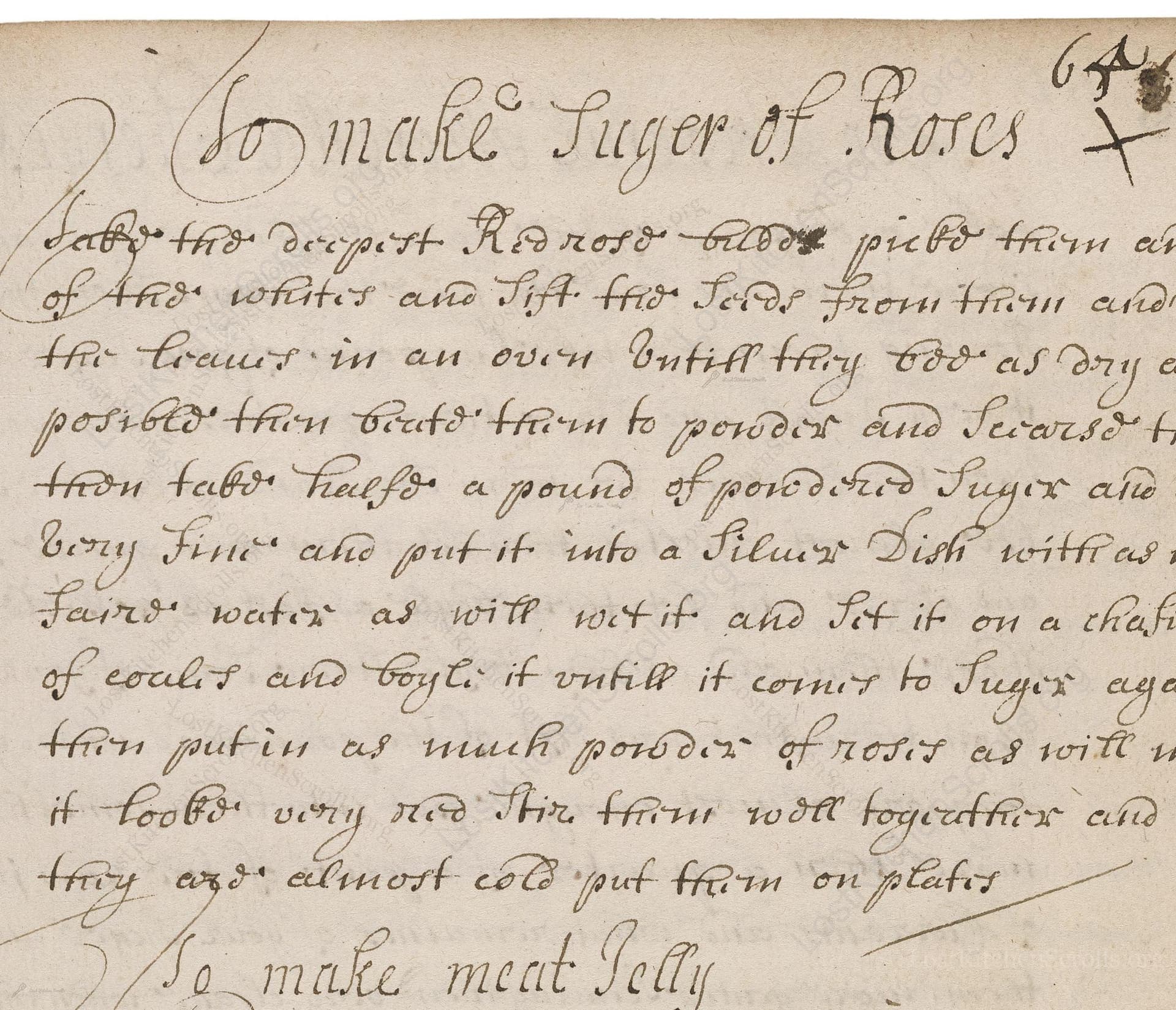To Make Sugar Of Roses
From the treasured pages of Cookery book of Ann Goodenough
Written by Ann Goodenough

To Make Sugar Of Roses
"Take the deepest Red rose leaves picke them and cut off the white and soft ends from them and dry the leaves in an oven untill they looke as dry as possible then beat them to powder and Searce them then take halfe a pound of powdered Sugar and beat it very fine and put it into a silver dish with as much faire water as will wet it and Set it on a chafindish of coales and boyle it untill it come to Sugar againe then put in as much powder of roses as will make it looke very red Stir them well together and when they are almost cold put them on platters"
Note on the Original Text
The recipe is written in a casual, almost conversational tone, typical of manuscript cookbooks of the 18th century. Spelling is non-standard ('leaves' for petals, 'faire' for fair/clean water, 'boyle' for boil), reflecting oral traditions and evolving English usage. Quantities and times are inexact, relying on a cook's judgment—only the sugar gets a definite weight, illustrating the high value placed on sugar. Instructions jump between methods (drying, powdering, boiling, mixing) in rapid succession, designed for readers familiar with kitchen processes and willing to adapt with experience.

Title
Cookery book of Ann Goodenough (1738)
You can also click the book image above to peruse the original tome
Writer
Ann Goodenough
Era
1738
Publisher
Unknown
Background
A delightful journey into the kitchens of early 18th-century England, this collection captures the flair and flavors of its time with recipes crafted by the inventive Ann Goodenough. Expect a charming medley of hearty roasts, comforting pies, and time-honored confections, perfect for those wishing to dine as they did in Georgian days.
Kindly made available by
Folger Shakespeare Library
This recipe originates from the early 18th century, handwritten by Ann Goodenough. At the time, edible flowers like rose were not only appreciated for their fragrance but also believed to have health benefits. Sugared flower preparations were considered both medicinal and luxuriously decorative, served at the tables of the well-to-do. Sugar of roses could be eaten as a sweetmeat, dissolved in drinks, or used to decorate desserts. Creating such confections at home reflected both culinary skill and social standing, as white sugar remained a prized ingredient in this era.

Historically, cooks used shallow ovens to dry petals (often residue heat from bread-baking), a mortar and pestle to powder the petals, a fine sieve for sifting, and a silver or tin dish to cook the sugar over a chafing dish or small brazier of coals. Wooden spoons for stirring and platters for drying and presenting the finished sugar were also essential. Modern equivalents are a low oven or dehydrator, spice grinder, fine-mesh sieve, heavy-bottomed saucepan, silicon spatula, and baking tray.
Prep Time
1 hr
Cook Time
10 mins
Servings
12
We've done our best to adapt this historical recipe for modern kitchens, but some details may still need refinement. We warmly welcome feedback from fellow cooks and culinary historians — your insights support the entire community!
Ingredients
- 2 ounces deep red rose petals (organic, food-grade)
- 8 ounces powdered (icing) sugar
- 1–2 tablespoons filtered water (as needed)
- Optional substitute: edible dried hibiscus petals for color if red rose petals are unavailable
Instructions
- Begin by selecting fresh, deep red rose petals (ensure they are organic and food-safe).
- Trim off any white and soft ends from the petals to avoid bitterness.
- Spread the petals on a baking tray and dry them in a low oven (about 120°F) until they are fully dried and crisp.
- Once cooled, pulverize the petals into a fine powder using a spice grinder or mortar and pestle, then sift to remove any remaining larger bits.
- Take 8 ounces of powdered (icing) sugar and mix it with just enough filtered water (about 1–2 tablespoons) to form a thick, wet paste.
- Transfer this mixture into a heavy-bottomed saucepan and heat gently, stirring, until most liquid cooks off and the sugar thickens and begins to look glossy—almost re-crystallizing.
- Add the powdered rose petals in sufficient quantity to give the sugar a pronounced rosy color, stirring well.
- Allow to cool until just warm, then spread or shape the fragrant sugar on a baking tray or platters to dry and set.
Estimated Calories
85 per serving
Cooking Estimates
You’ll need some time to dry and grind the rose petals, then mix and cook the sugar. Most of the active cooking happens quickly, but drying takes longer. This recipe makes about 12 servings, each with moderate calories mostly from sugar.
As noted above, we have made our best effort to translate and adapt this historical recipe for modern kitchens, taking into account ingredients nowadays, cooking techniques, measurements, and so on. However, historical recipes often contain assumptions that require interpretation.
We'd love for anyone to help improve these adaptations. Community contributions are highly welcome. If you have suggestions, corrections, or cooking tips based on your experience with this recipe, please share them below.
Join the Discussion
Rate This Recipe
Dietary Preference

Den Bockfisch In Einer Fleisch Suppen Zu Kochen
This recipe hails from a German manuscript cookbook compiled in 1696, a time whe...

Die Grieß Nudlen Zumachen
This recipe comes from a rather mysterious manuscript cookbook, penned anonymous...

Ein Boudain
This recipe comes from an anonymous German-language manuscript cookbook from 169...

Ein Gesaltzen Citroni
This recipe, dating from 1696, comes from an extensive anonymous German cookbook...
Browse our complete collection of time-honored recipes



